After the death of Jawaharlal Nehru in 1964, a question regarding his successor arose. There were two main contenders for the post of the Prime Minister namely, Morarji Desai and Lal Bahadur Shastri. Under a group of prominent Congress leaders known as Syndicate, it was decided that Shastri will succeed to the post of Prime Minister. He was sworn in to the post in June, 1964.
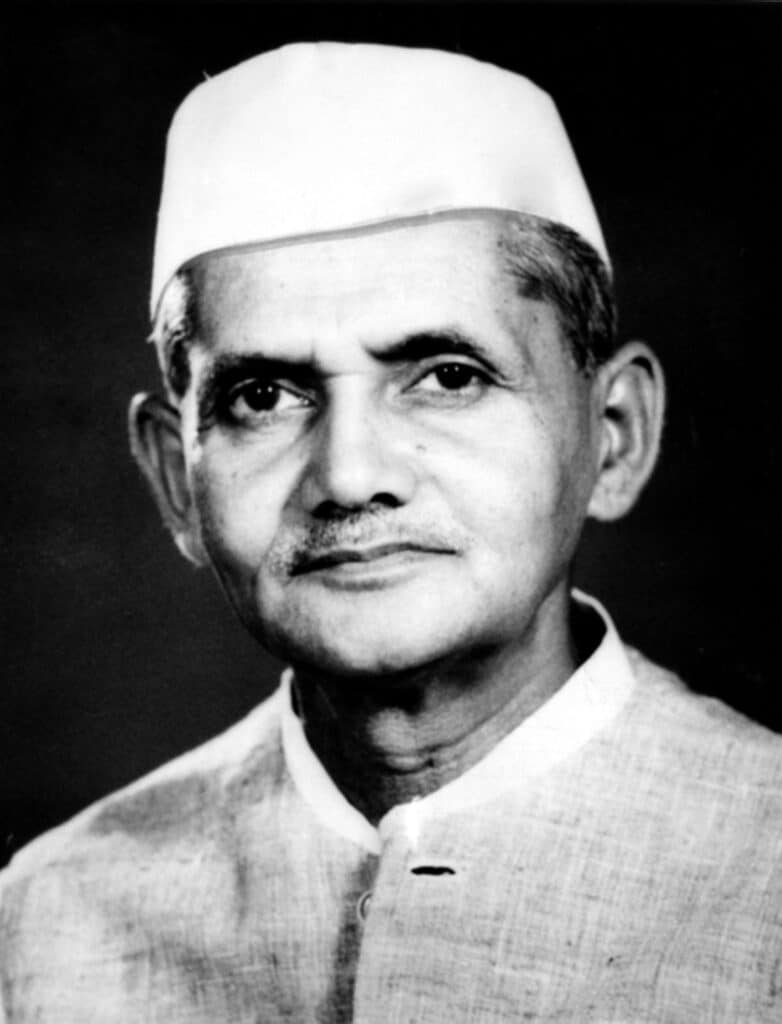
Challenges
When Lal Bahadur Shastri took the office of Prime Minister of India, he was faced with a number of challenges, which included the following:
- Stagnating economy, worsening Balance of Payments and severe shortage of food.
- Protests in Tamil Nadu for continuation of English as official language, beyond the period of fifteen years as provided by the Constitution in 1950.
- Demands for separate states (like in Punjab) and merger of Goa with Maharashtra.
- Naga demand for independence and associated insurgency in Nagaland.
- Kashmir issue and Pakistan’s designs in Kashmir.
- Growth in China’s power with nuclear test in October, 1964.
Response
- The problem of food crisis was dealt with the initiation of Green Revolution. It has been dealt in detail in the following discussions.
- Prime Minister Shastri gave assurance to the nonHindi speaking states that their right to transact their business in their regional language would be protected. He also assured them that the use of English as a language of correspondence between the center and the states would continue. However, he failed to find a lasting solution to the issue because he could not get convergence in the views of pro-Hindi and anti-Hindi groups.
- Demand for separate state in Punjab too was not dealt with in a decisive manner under Shastri and the matter was left to be solved by his successor Indira Gandhi.
- Though the state of Nagaland was created in 1963, peace eluded the region, as result of increase in insurgency. Under Shastri, no solution could be achieved for insurgency in the state.
- The issue of Kashmir started simmering during Lal Bahadur Shastri’s Prime Ministership. The unrest in the Kashmir valley was exploited by Pakistan which eventually resulted in a war between India and Pakistan in 1965. It is dealt separately in the following discussions.
- As China successfully tested a nuclear bomb, Dr. Homi J. Bhabha, the Atomic Energy Commission Director, who though personally stood for universal disarmament, said that India, in eventual situations, may go nuclear. But, Shastri did not favour these statements by Dr. Bhabha.
Lal Bahadur Shastri Era: Political Developments
Kamaraj Plan
After the defeat in the war against China in 1962, the image of not only the government but also that of the Congress Party eroded . Moreover, fifteen years in power made the party complacent. There were signs that it had lost touch with the ground realities. This was evident from the defeat in the by-elections and growing strength of the regional parties like DMK.
The Chief Minister of Madras K. Kamaraj saw the threat from the DMK. In order to check its rise and
in order to rejuvenate the Congress Party he recommended a measure known as ‘Kamaraj Plan’. Under it, he suggested that the senior party leaders should leave their ministerial posts and should focus on party rebuilding. In order to walk the talk he resigned from the post of Chief Minister in October, 1963. Six Union Ministers and six Chief Ministers including Lal Bahadur Shastri, Jagjivan Ram, Morarji Desai, Biju Patnaik and S.K . Patil followed suit and resigned from their posts.
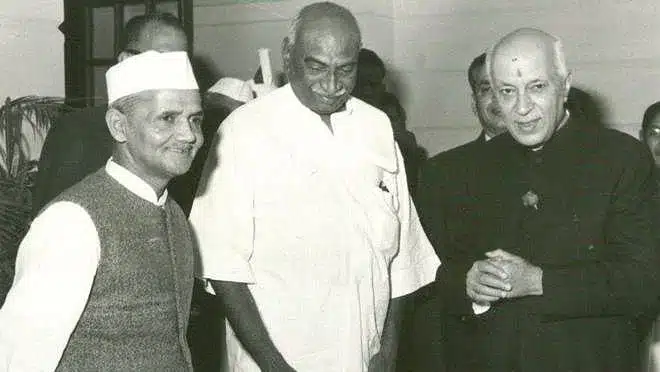
Kumaraswamy Kamaraj
Kumaraswamy Kamaraj (1903-1975) belonged to Nadar caste, one of the most depressed castes amongst the Hindus and was a well known leader of the Indian National Congress (INC). He played a leading role in shaping India’s destiny since the demise of Jawaharlal Nehru till the split in Congress in 1969, and, is widely known as ‘King Maker’ due to his role behind the rise of two great Prime Ministers of India i.e., Lai Bahadur Shashtri and Indira Gandhi.
He was elected unopposed to the Madras Legislative Assembly in 1937. Later, he was again elected to it, in 1946. He was, also, elected to the Constituent Assembly of India in 1946, and later to Parliament, in 1952.
He became the Chief Minister of Madras in 1954 and served till 1963 for three consecutive terms. On realizing a decline in INC’s enthusiasm, he resigned from his ministerial post and also asked other senior leaders to do so. After resigning from the post, he became a prominent leader of INC and served as its President for 4 years (1964-1967).
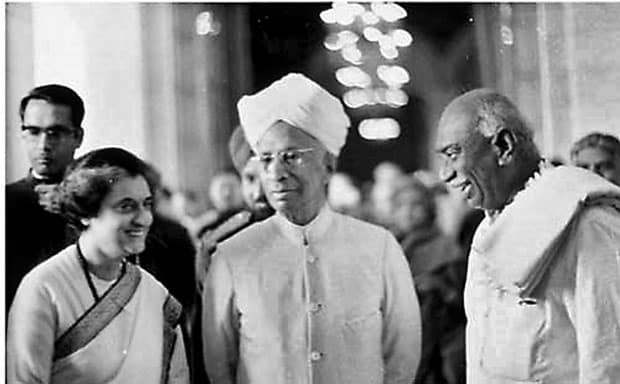
Rise of Regional Politics
India being a diverse country, the aspirations of people vary, which resulted in formation of various regional parties in the country.
DMK in Tamil Nadu
Formed in 1949 by Annadurai, it was initially an antibrahmin, anti-north and anti-hindi party, with demand for an independent nation-state of southern states, i.e. Dravidnadu. But, after realizing that its demand for the separate nation-state cannot be fulflled and it is possible to protect the Tamil culture within the sphere of unity, it toned down its demands. They also underplayed their anti-brahmin movement because it led to flight of Brahmins which affected the development of science and technology in Tamil Nadu. They began participation in the elections and formed government in Tamil Nadu in 1967, with Annadurai as the Chief Minister.
Shivsena in Maharashtra
It was formed in 1966 by Bal Thackeray with an agenda of ‘Bombay for Maharashtrians’. It sought to protect the regional interests, with demands like jobs for sons of soil. In a similar way to protect the regional aspirations, various other regional parties were formed in other parts of the country. For example, Telugu Desam Party was formed in early 1980s, Assam Gana Parishad was formed in Assam in 1985 etc.
Impact of Rise of Regional Parties
- The regional parties voiced regional interest which strengthened the Indian federation.
- They played a role in the formation of the coalition governments at the Centre.
- Their rise led to increase in the representation of the regional interests in Lok Sabha.
- Often, the regional parties used violent means to protect the regional interests. This aroused the subnational feelings which on various occasions created law and order problems.
Tashkent Agreement
Indo-Pak War (1965)
The unrest in the Kashmir valley during the 1960’s made the Pakistani leadership think that the situation could be exploited to annex Kashmir. They also thought to exploit the military preparedness going on in India after the China war. The dress rehearsal to the larger conflict came in the form of skirmish in the Runn of Kutch region.
In April 1965, the two militaries exchanged fire in the Runn. Due to the nature of the terrain and the use of American tanks by the Pakistani army, India’s military response was weak. But with the interference by the Britain, both the sides agreed to refer the dispute to international arbitration. Meanwhile, Sheikh Abdullah was arrested as he was going too far and was talking about possibility of independence for Kashmir. For this, he had met the Chinese Prime Minister.
The arrest of Abdullah and the clash in the Runn put an idea of infiltration in the mind of Pakistani President Ayub Khan. The fight in the Runn made him think that the Indian government and the armed forces are not ready for the war.
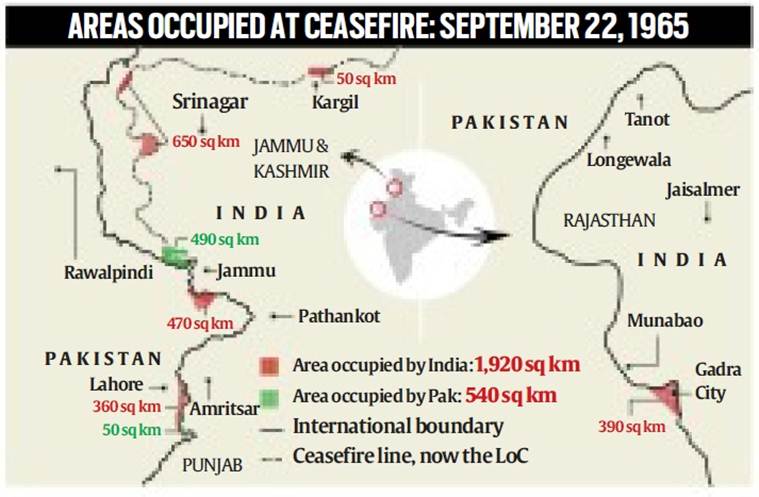
Offensive by Pakistan
Operation Gibraltar: (Named after a famous Moorish victory in medieval Spain): Under it, the trained infiltrators were sent by the Pakistan in the Kashmir valley in August 1965. The aim was to foment pro-Pakistan protests and to create conditions for military intervention. In order to counter this move, Shastri ordered the army to cross the line of control and to seal the passes through which infiltrators were coming.
Operation Grand-slam: When the idea of fomenting unrest in the valley did not succeed, the reserve plan was launched by Pakistani army. Under it, Pakistan launched a tank and infantry attack in Chhamb in south-west Jammu and Kashmir. Shastri ordered to not only defend Kashmir but also to open a new front across Lahore and Sialkot.
International Response
The escalation of hostilities alarmed superpowers. The US along with Britain cut off arms, food and other supplies to both India and Pakistan. The Chinese weighed in towards Pakistan and declared India as an aggressor. However, the Soviet Union discouraged China from supporting Pakistan. The United Nations Security Council made both countries to sign ceasefire. Both the sides suffered significant losses in the form of military personnel and, also, tanks, aircrafts, etc. because of which the war is often considered inconclusive.
Gains for India
(a) Infiltration of Kashmir was foiled.
(b) Indian force recovered pride, prestige and selfconfidence lost due to defeat in 1962.
(c) India emerged politically stronger and united.
Jai Jawan, Jai Kisan
During the Pakistan war the Prime Minister Shastri coined this slogan hailing soldiers and farmers. Through this slogan, he wanted to motivate the soldiers to fight the enemies and inspire farmers to produce more food grains to attain self-sufficiency in food production and reduce dependence on imports of food grains.
Question [2013]
Write a critical note on evolution and significance of the slogan ‘Jai Jawan Jai Kisan’. (200 Words)
Tashkent Declaration
After the cease-fire between India and Pakistan, the Soviet Union offered to help reach a peaceful settlement. This led to a meeting of Shastri and Ayub Khan with the Soviet Prime Minister as the chief mediator, in Tashkent. They agreed to Tashkent Declaration, in January 1966. Some of the important provisions of the declaration, are as follows:
- (a) Pakistan to give up on international arbitration of the Kashmir dispute.
- (b) India to withdraw from key posts like Haji Pir Pass and other strategic gains in Kashmir.
- (c) Withdrawal of forces by both the sides to the positions held before the war.
- (d) The orderly transfer of prisoners of war.
- (e) The resumption of diplomatic relations.
- (f) The disavowal of the force to settle future disputes.
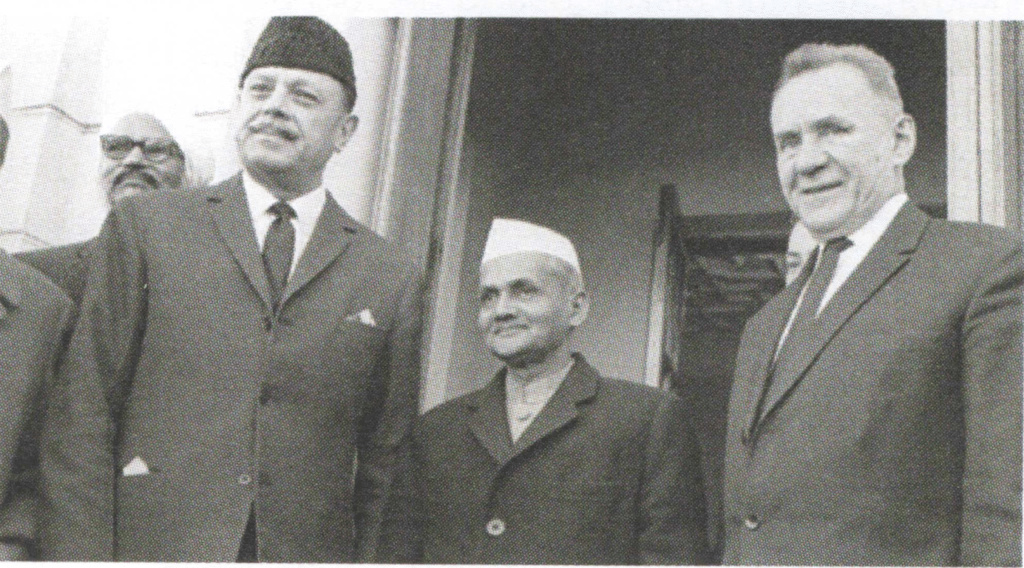
Question [2013]
Analyze the circumstances that led to the Tashkent Agreement in 1966. Discuss the highlights of the Agreements. (200 Words)
Reasons for Withdrawal from Haji Pir Pass
- The other option for India was the resumption of the mutually disastrous war.
- Also, denial to agree on the withdrawal would have led to loss of support from the Soviets in UNSC on the Kashmir issue and also loss of supply of defense equipments.
- During the course of the meeting, Indian Prime Minister Lai Bahadur Shastri died on 11th January, 1966, due to heart attack.
White Revolution
After independence there was an emphasis on the cooperatives as a means to improve agriculture and benefit the poor. In agriculture, particularly in land-reforms, it could not achieve the desired results due to various reasons. The most successful experiment in the cooperatives was the milk cooperatives. The success of milk cooperatives in meeting the milk demands of the people and improving the life standards of the people associated with milk cooperatives has been termed as white revolution.
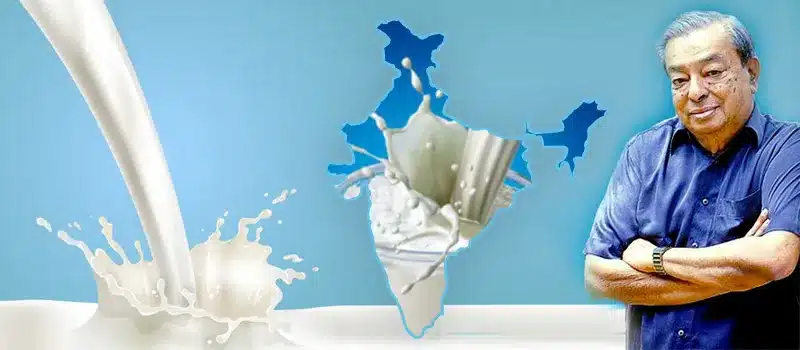
Background
The condition of the farmers of the Kaira district of Gujarat (in 1997, Kaira was divided and new Anand district was formed) was same as the farmers from rest of the country, after independence. The Bombay Milk Scheme started by the Government of Bombay in 1945 benefitted all except milk producers. The milk contractors took away the biggest share of profit.
The discontent amongst farmers grew. They met Sardar Vallabhbhai Patel for his advice, who had in 1942 advised them to set up their own cooperatives. He reiterated his advice to the farmers. He sent Morarji Desai to Kaira for the formation of the farmers cooperative. After some struggle with the Bombay government, in 1946, Kaira, District Cooperative Milk Producer’s Union was set up.
The objective of the Kaira Union was to provide proper marketing facilities to the milk producers of the district. It started supplying milk under the Bombay Milk Scheme. The Gandhian freedom fighter Tribhuvandas K. Patel, who persuaded farmers to form milk cooperatives became its first chairman in 1947. Dr . Varghese Kurien served as the Chief Executive of the union from 1950-73.
Amul
As the production increased, the Bombay Milk Scheme was unable to absorb the excess milk produced. Thus, a need was felt for a plant that could produce products like butter and milk powder from the excess milk. This led to the setting up of a plant in 1955. Further, it provided fillip to the cooperative movement amongst milk producers.
Kaira union introduced the name ‘Amur (Anand Milk Union Limited) for marketing of their products. This new venture achieved a major breakthrough by producing milk products from buffalo milk, a first of its kind in the world. In 1960, a new factory to manufacture cheese and baby food was set up. Thereafter, a modern plant to manufacture cattle feed was commissioned. It used computer technology to do cost-benefit analysis of prices of inputs for cattle feed and their nutritional value. With the spread of ‘Anand Pattern’ to other districts, in 1974, the Gujarat Cooperative Milk Marketing Federation Ltd was formed as an apex organization of the unions in the district to look after marketing.
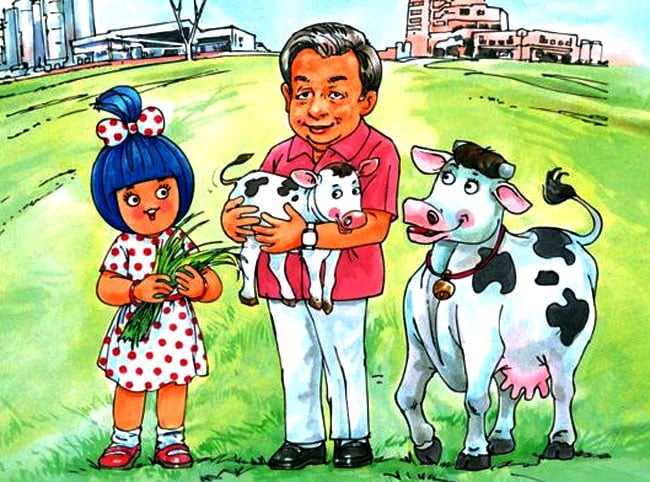
Reasons for Success
The project was successful due to following reasons:
- Visionary Leadership: Dr. Kurien provided a visionary leadership to the scheme. He solved the crucial problem of the milk marketing which according to him was the most crucial aspect to increase milk production.
- Veterinary Services: Veterinary services including artificial insemination service were made available to the producers to improve the quality of stock.
- Comprehensive Strategy: It envisaged a comprehensive programme of animal breeding, animal nutrition, and animal health and hygiene, livestock marketing and extension work on scientific lines. High quality fodder seeds, too, helped in milk production.
- Insurance: The milk producers were provided with insurance, which provided them security in case of death of milch animal.
- Awareness Campaign: Peasants were educated about the developments in animal husbandry. Women who generally look after animals were also educated. This gave them incentive to adopt scientific practices in the milk production which led to increase in the milk production.
- Democratic Model: The democratic model of functioning of cooperatives inculcated a sense of ownership amongst all the members, which played an important role in the increased milk production.
Impact
Improved Living Standards: It led to improvement in standards of living of poor and landless farmers. About 48% of the total income of the rural households of Kaira district came from districts.
- Collective Benefts: Some of the profts of the cooperatives was used to improve common facilities in the village like wells, roads, schools etc.
- Social Inclusion: As producers from various caste, class, gender and religion were the members of the cooperatives, it led to the social inclusion.
- Filip to Democracy: It promoted the spread of democracy as each member had one vote in the elections for chairmanship irrespective of the number of shares they held.
- The experience from Kaira helped in the growth of the ‘Operation Flood’.
National Dairy Development Board
In 1964, the then Prime Minister of India Lai Bahadur Shastri visited Kaira. After his discussions with Dr. Kurian he was keen to replicate this model of cooperatives success to other parts of India.
The keenness of the PM led to the formation of the National Dairy Development Board (NDDB) in 1965. It was headquartered in Anand. Dr . Kurian was its first chairman, who headed the body till 1998. Its aim was to strengthen the farmer’s cooperatives and to frame policies that are favourable to these institutions. It had the vision of transforming dairying into an instrument for the development of rural India.
On the insistence of Dr. Kurian, the NDDB was located in Anand. This actually proved to be beneficial as it was able to keep itself away from the traditional bureaucratic structure. Thereby, the NDDB did not acquire a structure of traditional inefficient government department, but it became an institution more suitable for its objectives.
Though set up to replicate the ‘Anand Pattern’ of Dairy development in other parts of India, NDDB did not restrict it to milk cooperatives. At the initiative of the NDDB cooperatives for fruits and vegetable producers, oilseed cultivators, small scale salt makers and tree growers were started. With this efforts cooperatives spread in various parts of India. For example, ‘Dhara’ a vegetable oil brand is a result of NDDB’s efforts.

Operation Flood
The National Dairy Development Board in 1969 designed a dairy development programme to lay the
foundation for a viable, selfsupportive national dairy industry. The programme sought to link rural milk production to urban milk marketing through the cooperatives.
In 1970, with the technical assistance from the United Nations Development Programme (UNDP) and the Food and Agriculture Organisation (FAO) the programme was launched as ‘Operation Flood’. It drew heavily from the Kaira Union for personnel, expertise, etc. It was envisaged to replicate the ‘Anand Pattern’ in other milk-sheds of the country .
Objective of Operation Flood
To organize cooperatives of milk producers into a nationwide grid, for:
- (a) Increasing milk production (a flood of milk)
- (b) Bringing producer and consumer closer by eliminating middlemen
- (c) Augmenting rural income
- (d) Ensuring reasonable price for consumer
The Programme Implementation
Operation Flood was implemented in 3 phases:
Phase 1 (1970-80): It was financed by the sale of skimmed milk powder and butter oil gifted by the European Union (then the European Economic Community) through the World Food Programme. The NDDB planned the programme and negotiated the details of EEC assistance. During its first phase, Operation Flood linked 18 of India’s premier milk-sheds with consumers in India’s major metropolitan cities: Delhi, Mumbai, Kolkata and Chennai; thus establishing mother dairies in four metros.
Phase 2 (1981-85): Under this phase coverage of the programme increased. Its objective was to establish a modern and self sustaining dairy industry, building on the foundation of Phase-I to meet the nation’s needs in milk and milk products.
Phase 3 (1985-96): It helped in the consolidation of the dairy cooperative movement in India. Under it, the infrastructure was expanded and strengthened to procure and market the increased amount of milk produced. It gave emphasis on research and development in animal health and animal nutrition, veterinary services like vaccines, etc.
Critical Analysis
Positives
- Increased Milk Production: Before the launch of ‘Operation Flood’ national milk production grew at 0.7%, but with the initiation of the programme, it grew at more than 4%.
- Poverty Alleviation: Dairying became an important source of income especially for small and landless farmers. About 60% of the beneficiaries of the programme were small and landless farmers. Thus, it acted as an important poverty alleviation tool.
- Access to Technical Inputs: A major impact of the programme was access to technical inputs. The farmers were provided with technical inputs including artifcial insemination, balanced cattle feed with mass protein feed, urea enriched straw, better fodder varieties, assured veterinary services, etc.
- Empowered Women: ‘Operation Flood’ along with NGOs like Self-Employed Women’s Association (SEWA) established about 6000 women dairy cooperative societies, managed by women. This enabled women participation in decision making at various forums.
- Spawned Dairy Machinery Industry: With this programme, there was an impetus to indigenous dairy equipment manufacturing industry , which later began exporting equipment.
- Employment Opportunities: The Operation flood opened new employment and income avenues for the vulnerable sections in rural areas; thus, slowing down the mass migration to the cities
- Export of Milk Powder: India became milk surplus country from being dependent on imports and gifts of milk powder and other dairy products. In a decade of launch of the programme, it began to export milk powder.
- Elimination of Intermediaries: The programme exterminated middlemen who were creaming off most of the profits by forcing unremunerative prices on dairy farmers.
Negatives
- Benefits to a Few: Around 90 per cent of the milk produced each year came from 12 states like Uttar Pradesh, Punjab, Haryana, Rajasthan, Maharashtra, Tamil Nadu and, of course, Gujarat. Even in these states, the bulk was confined to a few pockets. It has been found that it benefited the affluent section.
- Strengthened Intermediaries: Far from eliminating the exploitative intermediaries/ elements cooperatives helped them to emerge as political power centres.
- Opaqueness of NDDB: The NDDB which spearhead the programme has been criticized for its opaqueness to government scrutiny.
Conclusion
‘Operation Flood’ was not just a dairy development programme. It saw dairying as a path towards development; an initiative for employment generation and to alleviate poverty. Thus, it helped in socio-economic endeavours of the country.
Green Revolution
Green Revolution is the phenomenon that is identified with India’s transition from an import dependent country for food to a self-sufficient one, which later became a surplus country in food. It is related with major technological reforms undertaken in Indian agriculture from mid- 1960s. The project was led by Dr. M.S. Swaminathan, an Indian geneticist and biologist. Though Indian agriculture grew by about 3% during 1949 and 1965, India faced food shortage particularly from early 1960s. This was a result of rise in population after independence and slow but steady rise in per capita income along with rising outlay towards planned industrialization. Due to these pressures on Indian agriculture, it was not able to fulfill the rising demands.
As a result of this food shortage, India was compelled to import increasing amounts of food. For example, India had to make a controversial agreement to import food from the USA under the PL-480 scheme in 1956. The volume of food imported under this kept on rising year-by-year.
Added to this, India had to fight wars with China (1962) and Pakistan (1965). The situation was further aggravated with droughts in the year 1965-66, which affected the agriculture production domestically. Famine like conditions started setting in. Due to this, food availability went down leading to price rise.
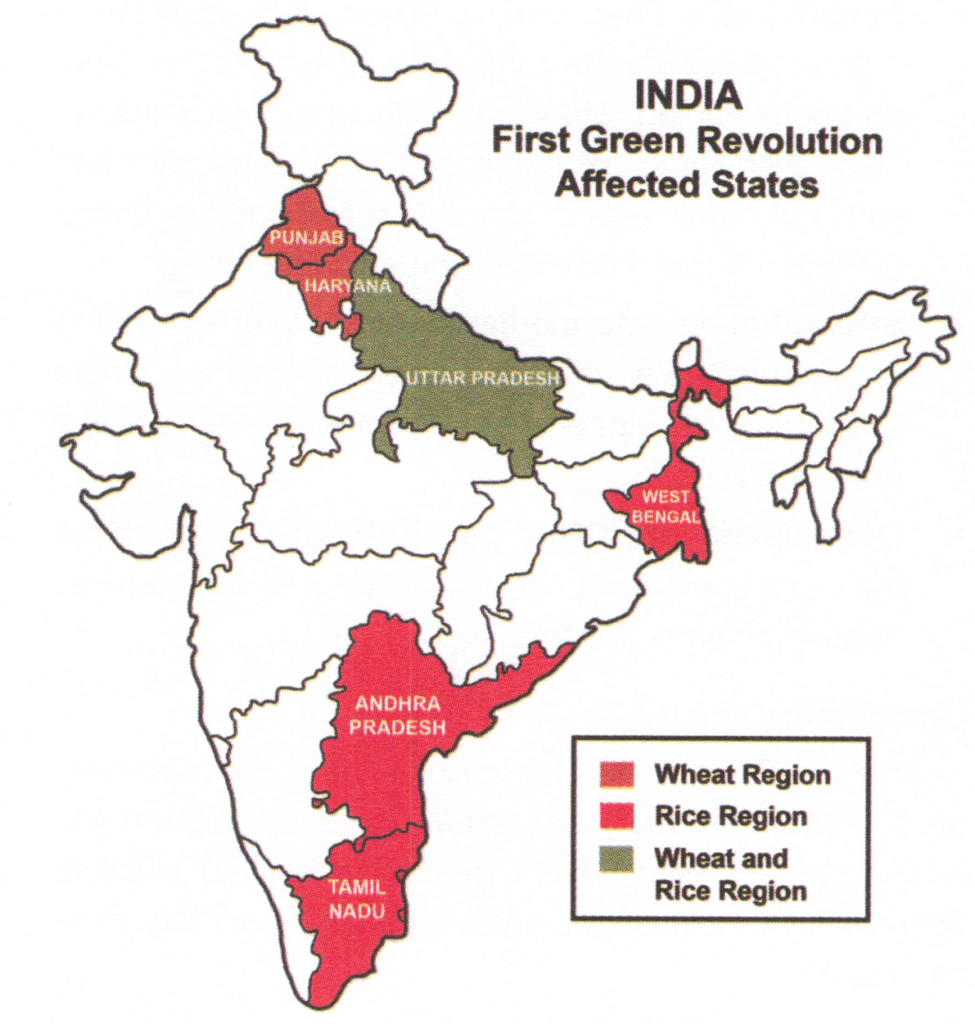
Threat from the USA
In this backdrop, India fought a war with Pakistan in 1965. The US sympathized with Pakistan. Moreover, India’s strong condemnation of American action during Vietnam war did not favour the US. Hence, in order to arm twist India to accept economic policy favourable to it, the US threatened to stop the food exports, which till then had helped India meet its food demand.
Towards Self-Reliance
In the above discussed situation, economic self-reliance, particularly food self-sufficiency became the priority of Indian economic policy. The then Prime Minister, Lai Bahadur Shastri along with Indira Gandhi gave full support to New Agriculture Strategy, under which focus was given on:
- High Yield Variety (HYV) seeds (Mexican dwarf wheat)
- Chemical fertilizers and pesticides Agriculture machinery including tractors, pump-sets etc.
- Soil testing facilities
- Agriculture education programme
- Institutional credits with focus on areas which had assured irrigation facilities along with supporting agriculture infrastructure.
Other Measures Taken
- Government investment in agriculture increased significantly.
- Efforts were made to ensure that the farmers have assured markets at remunerative prices. The Agriculture Prices Commission was set up in 1965 to recommend the prices for agriculture produce like wheat and rice. In 1985, it was renamed as the Commission for Agriculture Costs and Prices (CACP) to recommend minimum support prices for multiple food-grains.
- All these initiatives by the government also led to increase in gross capital formation in agriculture.
Critical Analysis
Positives
- Increase in Agricultural Production: Food production rose by 35% during 1967-68 and 1970-71. This led to increase in food availability as marketable surplus of food-grains increased.
- Decrease in Food-Grain Imports: Net food imports fell from 10.3 million tonnes in 1966 to 3.6 million tonnes in 1970.
- Food-Grain Exports: By 1980s, India not only had buffer of food-grains, but it also started exporting food-grains.
- Prosperity for Farmers: With the increase in farm production, the earnings of the farmers also increased and they became prosperous. It brought prosperity to farmers.
- Rural Employment: It generated more rural employment due to multiple cropping. Moreover, as a result of agro-industries, warehousing for agriculture produce, transport, fertilizers, manufacturing of farm equipments, etc. resulted into increase in the overall employment in the country.
- Poverty Alleviation: Further, the surplus generated under the Green Revolution helped the government to launch schemes for employment generation. This had a major impact on the poverty alleviation.
- Industrial Growth: The need for agriculture equipment contributed to industrial growth. Besides, demand for chemical fertilizers, pesticides, insecticides, weedicides, etc. also increased considerably.
- Capitalist Farming: The attitude of farmers towards farming changed. They started investing in agriculture; thereby, shifting to capitalist farming.
Negatives
- Regional Benefits: The benefits of green revolution accrued mainly in Punjab, Haryana and western Uttar Pradesh in the north and Andhra Pradesh and Tamil Nadu in the south that already had certain prerequisites, such as irrigation facilities, capital for investment, among others. It hardly touched the Eastern region, including Assam, Bihar, West Bengal and Orissa and arid and semi-arid areas of Western and Southern India
- Food Crop Centred: The effect of Green Revolution was primarily felt on food-grains. Major commercial crops like cotton, jute, tea and sugarcane were almost untouched by the revolution. As a result, an excess of production in two main food-grains (wheat and rice) and shortages in mostly others prevailed side by side.
- Social Inequality: The benefits of the Green Revolution were cornered by the big farmers, at the expense of small farmers and tenants. This contributed to increase in social inequality .
- Rural Unemployment: The mechanization of agriculture led to rural unemployment, especially amongst agricultural labourers. The worst hit were the poor and the landless farmers or people.
- Environmental Degradation: Excessive use of chemical fertilizers and pesticides resulted in environmental degradation. Over irrigation, especially in Punjab and Haryana, has depleted groundwater tables and led to salinization of soil in the region.
Conclusion
The Green Revolution contributed to the increase of food production in the country; thereby, making it self-sufficient and import independent. It had many spill-over advantages like increase in rural income, employment opportunities, etc. But, atthe same time, the environmental consequences of the use of chemical fertilizers were real. As India is embarking on the path of Second Green Revolution, we must learn lessons form First Green Revolution. This will help us to practice environmentally sustainable agriculture in the era of climate change.
Food Corporation of India
The Food Corporation of India (FCI) was set up in 1965, under the Food Corporations Act 1964. It was set up for the purchase, storage, movement , transport, distribution, sale of food-grains and other food-stuff. It was set up in order to fulfill following objectives of the Food Policy:
- Effective price support operations for safeguarding the interests of the farmers.
- Distribution of food grains throughout the country for public distribution system (PDS).
- Maintaining satisfactory level of operational and buffer stocks of food grains to ensure National Food Security.
Achievements
- (a) Under it, the level of procurement has increased.
- (b) India’s dependence on import has decreased.
- (c) It has helped in arresting fall in the prices to an unremunerative level for the farmers.
- (d) It has helped the people falling under the BPL category to meet their food requirements.
- (e) It has helped to arrest inflationary pressures.
- (f) Under it, scientific storage capacity has increased in India.
Challenges
- With the rise in procurement prices of the food-grains, the cost of FCI’s functioning has increased.
- The FCI faces the problem of rising costs of storage and distribution.
- There is, also, an issue of excess stock which leads to wastage of food-grains.
- The issue price has decreased, which has affected profits of the FCI.
Prospects
The government in 2014 had appointed Shanta Kumar Panel to suggest measures to improve the efficiency of the FCI. It has recommended decentralized procurement system. It has also recommended to restructure FCI’s debt so as to reduce interest burden. These recommendations are yet to be accepted by the government.
Lai Bahadur Shastri Years: Critical Analysis
Though as the Prime Minister of India, Lai Bahadur Shastri had a brief tenure of 19 months, still, he had a significant impact on the course of nation building.
Achievements
- The most important achievement under Shastri was initiation of the Green Revolution and setting up of the National Dairy Development Board (NDDB) which led the country towards White Revolution.
- Under Shastri, Indian Army successfully faltered intentions of Pakistan to annex Kashmir in 1965. Though indecisive, the war of 1965 gave boost to the morale of the army and of the nation as a whole.
- His slogan of ‘Jai Jawan Jai Kisan’ is still relevant in India.
- Though Shastri refuted the plan to acquire a nuclear weapon, it was during his premiership that the talks for nuclear weapon were held for the first time.
- He set up his own Prime Minister’s Secretariat, which later became popular as Prime Minister’s Office (PMO).
Criticism
- His tenure was criticized for following the policy of drift. Many issues were not solved and were merely left for the later leaders to solve. For example, the issue of the Official Language. Also, Shastri failed to solve the problem of Punjab as a separate state , which later escalated and took a violent turn.
- On the economic front, except agriculture, his tenure did not see much movement and continued to grow at a low rate of around 3.5%, which is known as the Hindu growth rate.
Conclusion
Despite some indecisiveness in the government policies under Shastri, his overall tenure helped India to become self-sufficient and later to become an exporter of the foodgrains. Thus, his tenure led the foundations on which industrial growth could be achieved later.

I appreciate🙏 your afforts, sir thanks to providing valuable note.